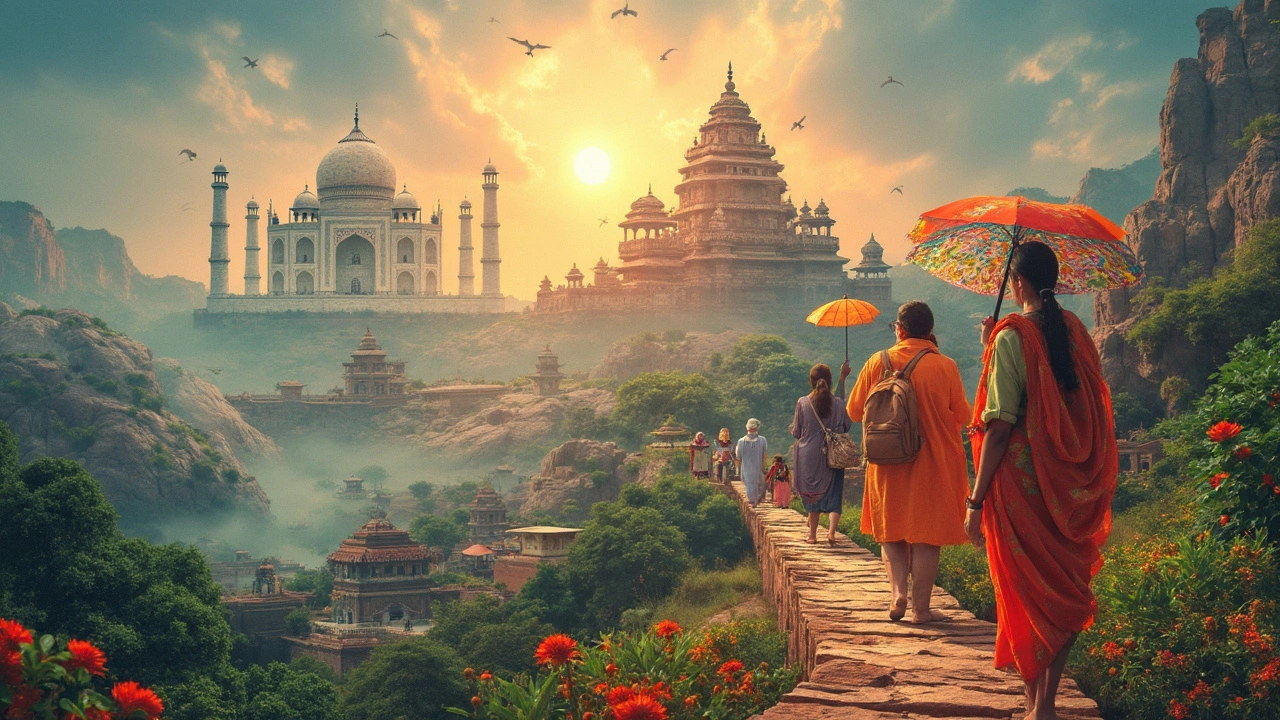Think India’s old palaces are just pretty backdrops? They’re part of a much bigger story. In 2024, India boasts 42 UNESCO World Heritage Sites, making it one of the top countries on the global heritage list. This number isn’t just another trivia stat—these places are living proof of wild architecture, deep-rooted traditions, and some jaw-dropping natural wonders.
If you grew up hearing about the Taj Mahal, you might not know India’s heritage list stretches from the snow-capped Western Ghats to bustling city landmarks like Mumbai’s Victorian buildings. The latest site on the list? The Sacred Ensembles of the Hoysalas landed their UNESCO tag in September 2023, putting lesser-known Karnataka temples into the international spotlight. These new additions keep things exciting and, honestly, keep your travel bucket list in permanent overflow mode.
What does all this mean for travelers or curious souls stuck at their desks? These are more than old stones and monuments—they’re places where history actually feels alive. And with sites spread from Ladakh’s cold desert to Tamil Nadu’s tropical marvels, there’s something for every kind of explorer.
- India’s Total UNESCO Heritage Sites in 2024
- Types of Heritage Sites: What Gets the UNESCO Tag?
- Must-Visit Sites and Hidden Gems
- Tips for Visiting India’s UNESCO Sites
India’s Total UNESCO Heritage Sites in 2024
If you’re trying to keep up with UNESCO heritage sites around the world, India is definitely a heavyweight. In 2024, India counts a total of 42 UNESCO World Heritage Sites. This keeps India in the top ten globally—only countries like Italy, China, and Germany have more.
These 42 sites aren’t all ancient temples or crumbling forts either. India’s collection includes monuments, natural parks, and even modern cityscapes. There are 34 cultural sites, 7 natural sites, and one mixed-type site: Khangchendzonga National Park in Sikkim, which ticks both the cultural and natural boxes.
| Type | Number |
|---|---|
| Cultural | 34 |
| Natural | 7 |
| Mixed | 1 |
This mix shows just how wide India’s heritage reach goes, from the Mughal splendor of Agra to the wild beauty of Kaziranga National Park. The most recent landmark to get the UNESCO nod is the Sacred Ensembles of the Hoysalas in Karnataka, recognized in late 2023 for their mind-blowing temple architecture.
Want to find the full list? UNESCO’s website has the latest details, but here are some standout names you’ll probably recognize:
- Taj Mahal (no surprise here)
- Qutb Minar and its Monuments, Delhi
- Sun Temple at Konark
- Great Himalayan National Park
- Western Ghats
- Victorian Gothic and Art Deco Ensembles of Mumbai
Short on time and want to catch the top highlights? These big names get all the attention, but don’t skip the lesser-known gems—some of India’s most interesting stories come from places you won’t find on tourist magnets or TikTok feeds.
Types of Heritage Sites: What Gets the UNESCO Tag?
Ever wondered what it takes for a place in India to become a UNESCO World Heritage Site? It’s not a casual club. Sites get the stamp if they show outstanding universal value—not just coolness to locals, but something the whole world can geek out about. These sites get sorted into three main categories: cultural, natural, and mixed.
- Cultural Sites: These make up most of India's heritage sites. We’re talking ancient temples, forts, monuments, and old cities. Think the Taj Mahal, but also places like the Qutub Minar or Jaipur’s walled city. If it’s art, architecture, or a slice of living tradition, it fits here.
- Natural Sites: Not just old rocks or forests—these spots are unique ecosystems or landscapes. Kaziranga National Park, for example, is famous for rhinos and stunning wetlands. Don’t forget the Western Ghats—packed with unique plants, animals, and jaw-dropping views.
- Mixed Sites: Some sites blend both culture and nature, but India currently has just one: Khangchendzonga National Park in Sikkim. Here, you’ll find wild beauty and spiritual legends tangled together.
There’s an actual checklist UNESCO uses before tagging a place. The spot must meet at least one out of ten tough criteria. It could be a marvel of human genius (like Humayun’s Tomb), a place where nature went extra (like Sundarbans), or somewhere with a major role in history. The nomination goes through strict reviews—no shortcuts or star power tilt.
| Type | Count |
|---|---|
| Cultural | 34 |
| Natural | 7 |
| Mixed | 1 |
So next time you read about a new UNESCO World Heritage Site in India, know that it’s not just about fame. It’s about passing a global test of culture, nature, and meaning—stuff that sticks with you way after you visit.

Must-Visit Sites and Hidden Gems
Everyone knows the UNESCO heavyweights like the Taj Mahal and Qutub Minar. These places get all the camera flashes and make it to travel magazines every year. But if you’re in the mood for something a little more unexpected, India’s heritage list is full of surprises. There’s way more to see than just the big names.
- Taj Mahal (Agra, Uttar Pradesh): This is India’s most recognized heritage site. Over 6 million people visit every year. If you go, aim for early morning before the crowds show up.
- Ajanta and Ellora Caves (Maharashtra): Ancient monks chiseled out these cave temples about 2,000 years ago. The Ajanta caves are famous for their Buddhist paintings, while Ellora showcases Buddhist, Hindu, and Jain monuments all in one place.
- Khajuraho Group of Monuments (Madhya Pradesh): They’re famous for those bold stone carvings. This site actually represents India’s artistic risk-takers from the 10th century. The evening light and sound show gives the temples a whole new vibe.
- Great Living Chola Temples (Tamil Nadu): The Brihadeeswarar Temple in Thanjavur is over 1,000 years old and was built out of granite, which they somehow hauled for miles without modern machinery.
- Kaziranga National Park (Assam): Not just monuments—nature makes the list too. This park has two-thirds of the world’s one-horned rhinos. Go on a jeep safari in winter for your best chance at spotting them.
Now, if you want a story to tell that none of your friends can top, check out these hidden gems:
- Khangchendzonga National Park (Sikkim): It’s India’s first "Mixed" UNESCO site, meaning it’s recognized for both nature and culture. You’ll spot snow leopards if you’re lucky, and local stories claim this area is a spiritual hotspot.
- Rani-ki-Vav (Patan, Gujarat): This 11th-century stepwell was buried under mud until the 1980s. Now, it’s on the UNESCO list for its unique inverted temple design and amazing sculptures.
- The Sacred Ensembles of the Hoysalas (Karnataka): Added in late 2023, these temple complexes aren’t just for history buffs. You’ll see pillars so detailed that each one looks like it took years on its own.
- Churches and Convents of Goa: We aren’t talking beach shacks here. These colonial-era churches bring out the Portuguese side of Indian history with beautiful tile work and massive pipe organs.
| Site | Location | What Makes it Special |
|---|---|---|
| Taj Mahal | Uttar Pradesh | Architectural icon, marble mausoleum |
| Ajanta Caves | Maharashtra | Ancient Buddhist frescoes |
| Khangchendzonga NP | Sikkim | Mixed heritage (nature+culture) |
| Rani-ki-Vav | Gujarat | Stepwell, intricate carvings |
If you want to dodge crowds and see something fresh, plan visits on weekdays and try sunrise or sunset hours for the best experience. Most spots have local guides—it’s worth grabbing one to get all the quirky stories you won’t find on info-boards. These India heritage sites are all about discovery, history, and brag-worthy adventures.
Tips for Visiting India’s UNESCO Sites
If you want to really enjoy the UNESCO heritage sites in India, you need a bit of planning. The best sites can get crowded, especially the famous ones like the Taj Mahal or Jaipur’s forts, so timing and preparation matter.
- Book tickets online when you can. For spots like the Taj Mahal or Qutb Minar, online tickets let you skip lines and sometimes save money. Most major sites now have official booking portals.
- Go early in the day—or late afternoon. This trick works especially well at places like the Ellora Caves or Fatehpur Sikri, where temperatures soar and crowds swell midday.
- Check dress codes. Many heritage sites in India are religious or have specific rules. For temples, churches, or mosques (like Hampi or the Churches of Goa), cover your knees and shoulders. Carry a scarf for sudden rules.
- Pack light, smart, and safe. Bring water, sunscreen, and good shoes. Don’t lug big backpacks—security checks can be strict, especially at high-traffic places like Red Fort or the Sun Temple at Konârak.
- Hire official guides. They're worth it at big spots like Agra Fort or Khajuraho, where a guide can bring hidden history to life. Check they have a government badge—skip the “unofficial” offers at the entrance.
- Respect the rules and preserve the sites. These are not just old ruins—they’re irreplaceable. Don’t carve your name, step on fragile carvings, or pick up stones. Fines and bans are real, especially at UNESCO-protected places.
- Mix it up with less-crowded gems. Sites like Pattadakal or the Western Ghats are just as incredible but see fewer tourists. You’ll get more time, cooler photos, and fewer Instagram photobombers.
India’s weather can be a gamechanger. Here’s a quick look at the best visiting months for different regions:
| Region/Site | Best Time to Visit |
|---|---|
| North India (Taj Mahal, Red Fort) | October–March |
| South India (Hampi, Mahabalipuram) | November–February |
| Mumbai, Western Ghats | December–March |
| Eastern India (Konârak Sun Temple) | October–February |
And here’s one more heads-up: Friday is the Taj Mahal’s weekly closure, so plan accordingly. For festivals like Diwali or Holi, sites in big cities can get packed, but you’ll also catch the heritage spots at their most vibrant.
Keep an eye out for UNESCO’s official blue plaques on each site—they’re your sign you’re standing somewhere globally recognized. That’s bragging rights, right there.
